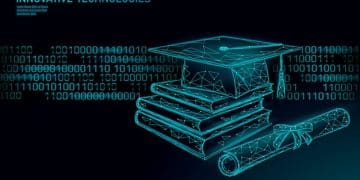Decoding Federal Student Loan Forgiveness Programs: Latest Updates

Decoding the Latest Updates to Federal Student Loan Forgiveness Programs involves understanding the recent changes, eligibility requirements, and application processes for various initiatives designed to ease the burden of student loan debt for eligible borrowers.
Navigating the complexities of federal student loan forgiveness programs can feel overwhelming. This article breaks down the latest updates to help you understand your options and potential eligibility for decoding the Latest Updates to Federal Student Loan Forgiveness Programs.
Understanding Federal Student Loan Forgiveness Programs
Federal student loan forgiveness programs aim to alleviate the financial burden of student loan debt for borrowers who meet specific criteria. These programs offer a pathway to have a portion or the entirety of their federal student loans forgiven, providing much-needed relief and financial flexibility.
Several forgiveness programs exist, each with its own set of requirements and benefits. Some programs target specific professions, such as teaching or public service, while others are designed to assist borrowers with income-related hardships or disabilities.

Types of Federal Student Loan Forgiveness Programs
Understanding the different types of forgiveness programs is the first step towards finding the right fit for your circumstances.
- Public Service Loan Forgiveness (PSLF): For those employed by government organizations or eligible non-profits.
- Income-Driven Repayment (IDR) Forgiveness: For borrowers with income-related hardships.
- Teacher Loan Forgiveness: For qualified teachers who teach full-time in low-income schools.
Keep in mind that eligibility requirements can change, so it’s important to stay informed.
In conclusion, federal student loan forgiveness programs are designed to provide financial relief to eligible borrowers, but understanding the different types and staying informed about changes is crucial.
Recent Changes to Public Service Loan Forgiveness (PSLF)
The Public Service Loan Forgiveness (PSLF) program has undergone significant changes in recent years, aimed at making the program more accessible and effective for eligible public service employees. These changes address some of the historical challenges and complexities that borrowers have faced when pursuing PSLF.
One of the most notable changes is the introduction of temporary waivers and flexibilities designed to provide borrowers with additional opportunities to qualify for forgiveness.
Temporary PSLF Waiver
The temporary PSLF waiver allowed borrowers to receive credit for past payments that previously didn’t qualify under the program’s strict rules. This waiver has now expired, but it significantly impacted many borrowers.
- Allowed credit for all prior payments, regardless of loan type or repayment plan.
- Required borrowers to consolidate non-qualifying loans into Direct Loans.
- Provided a limited-time opportunity for borrowers to receive forgiveness.
These changes were designed to help more public servants receive the loan forgiveness they were promised.
In conclusion, the recent changes to the PSLF program, including the temporary waiver, have provided more opportunities for public service employees to receive loan forgiveness.
Income-Driven Repayment (IDR) Adjustments and Forgiveness
Income-Driven Repayment (IDR) plans offer a lifeline for borrowers struggling to repay their federal student loans by setting monthly payments based on income and family size. Recent adjustments to IDR plans aim to make these plans more accessible and lead to faster forgiveness for eligible borrowers.
These adjustments often involve changes to the calculation of monthly payments, the definition of discretionary income, and the overall forgiveness timeline.

IDR Account Adjustment
The IDR account adjustment is a one-time review of all IDR accounts to credit borrowers with time towards forgiveness.
- Counts any month in repayment, regardless of the repayment plan.
- Includes months in deferment before 2013.
- Applies to Direct Loans, FFEL loans, and Perkins loans (if consolidated).
This adjustment could bring many borrowers closer to forgiveness, possibly even resulting in immediate forgiveness for some.
In summary, adjustments to Income-Driven Repayment plans are aimed at making loan repayment more manageable and accelerating the path to forgiveness for eligible borrowers.
Who is Eligible for These Forgiveness Programs?
Eligibility for federal student loan forgiveness programs varies depending on the specific program. While some programs are broad in their eligibility criteria, others target specific professions or borrowers with unique circumstances.
Understanding the eligibility requirements for each program is crucial to determine if you qualify for forgiveness.
Key Eligibility Factors
Several factors determine your eligibility for forgiveness, including employment type, loan type, and repayment plan.
Borrowers should carefully review the eligibility criteria for their desired programs to ensure they meet all requirements.
In conclusion, eligibility for federal student loan forgiveness programs is determined by a variety of factors, and borrowers should carefully review the requirements to determine if they qualify.
How to Apply for Student Loan Forgiveness
The application process for student loan forgiveness programs can vary depending on the specific program. However, there are some general steps that borrowers can expect to follow when applying for forgiveness.
Knowing what to expect during the application process can help borrowers prepare and avoid common mistakes.
Steps in the Application Process
The application process typically involves completing an application form and submitting documentation.
- Complete the application form for the specific forgiveness program.
- Gather required documentation, such as employment verification or income statements.
- Submit the application and documentation to the appropriate loan servicer or agency.
Borrowers should be prepared to provide accurate and complete information to avoid delays or denial of their application.
In conclusion, applying for student loan forgiveness involves completing the necessary application forms and submitting required documentation, ensuring accuracy and completeness to avoid delays.
Navigating Potential Challenges and Avoiding Scams
Navigating the complexities of student loan forgiveness programs can present challenges, and borrowers should be aware of potential pitfalls and scams. Staying informed and cautious can help borrowers avoid making costly mistakes.
Common challenges include understanding eligibility requirements, completing the application process correctly, and dealing with potential delays or denials.
Avoiding Student Loan Forgiveness Scams
Beware of companies charging fees for services that are available for free.
- Never pay upfront fees for loan forgiveness assistance.
- Be wary of unsolicited offers or promises that sound too good to be true.
- Always verify information with the Department of Education or your loan servicer.
Staying vigilant and informed will help you avoid scams and navigate the forgiveness process successfully.
In summary, navigating potential challenges and avoiding scams in the student loan forgiveness process requires staying informed, being cautious, and avoiding paying for services that are available for free through official channels.
| Key Point | Brief Description |
|---|---|
| ✅ PSLF Changes | Temporary waiver expanded eligibility for public servants. |
| 💰 IDR Adjustments | One-time account adjustment credits time towards forgiveness. |
| ⚠️ Scam Awareness | Avoid paying for free services; be wary of unsolicited offers. |
| 📝 Application | Complete forms accurately and submit all required documentation. |
Frequently Asked Questions (FAQ)
▼
PSLF forgives the remaining balance on your Direct Loans after you have made 120 qualifying monthly payments while working full-time for a qualifying employer. Qualifying employers include government organizations and certain non-profit organizations.
▼
The IDR account adjustment is a one-time review of all IDR accounts to credit borrowers with time towards forgiveness. It counts any month in repayment, regardless of repayment plan, and can bring borrowers closer to forgiveness.
▼
Generally, Direct Loans are eligible for most federal loan forgiveness programs. Other loan types, such as FFEL and Perkins loans, may become eligible if consolidated into a Direct Consolidation Loan.
▼
The application process varies depending on the program. Typically, you’ll need to complete an application form and submit required documentation, such as employment verification or income statements, to your loan servicer.
▼
Never pay upfront fees for loan forgiveness assistance, and be wary of unsolicited offers or promises that sound too good to be true. Always verify information with the Department of Education or your loan servicer.
Conclusion
Staying informed about the latest updates to federal student loan forgiveness programs is crucial for borrowers seeking relief from their student loan debt. By understanding eligibility requirements, application processes, and potential challenges, borrowers can navigate these programs effectively and take steps towards a brighter financial future.





